Photo Walk
For my second day in Cusco, I got up early and met with a local photographer to take some artsy shots around the scenic streets of Cusco. We met at my hotel, took a taxi to the San Blas neighborhood, and walked back, taking photos along the way. It was fun, but a bit stiff. He had a translator with him, as he is Italian and now lives in Cusco, so he speaks Italian and Spanish, but not English. The translator was a lady from Argentina I think(?), and she was very helpful, mostly at holding my purse while we took photos.
We walked through the narrow streets in the early morning, so it was still quite chilly out, and there were very few people. We picked scenic overlooks and nice water fountains. We walked by the 12-angled stone. It was a very pleasant walk, almost like a mini walking tour of the city.

Nice overlook spot 
Beautiful narrow city streets 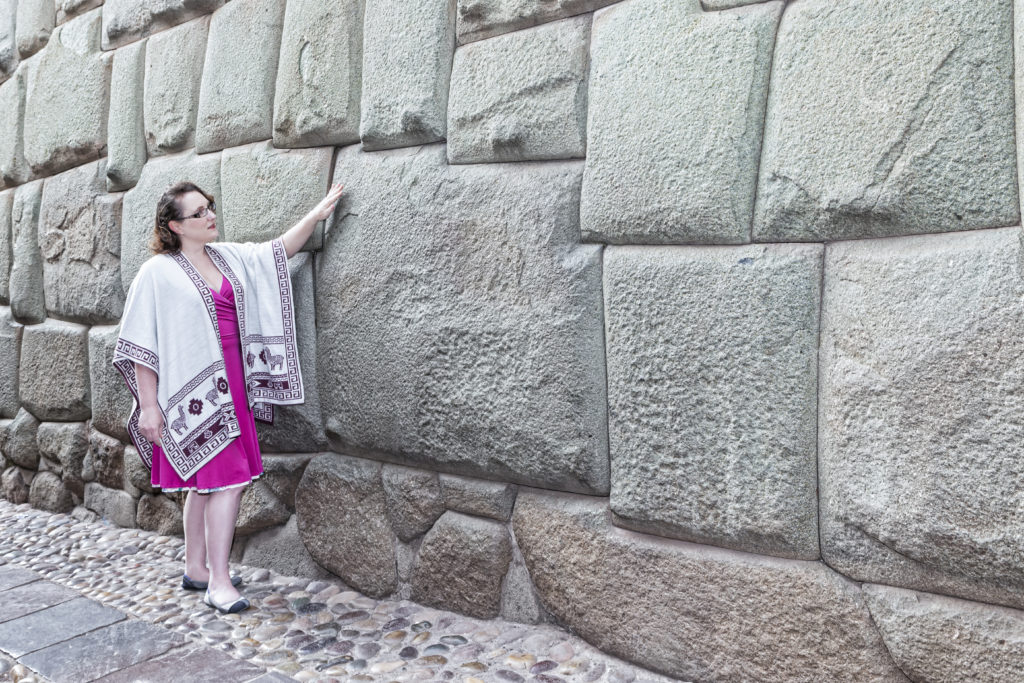
The 12-angled stone (you aren’t allowed to touch it)
I do want to share this story, as it amused me greatly. At one point, we were walking down a busier street. And there was an American het couple walking ahead of us. The woman was a good 6 feet ahead of the man and not slowing down. The man was trying to keep up, but there was a street vendor trying to get him to buy a wool hat or sweater. The guy says to the woman “I was just curious what the cost difference is between this and what’s in the shops.” And she immediately shot back “Stop being curious.” Ahh, women have been conditioned to never give men on the street the time of day, and it is utterly perplexing when otherwise sane men talk to strangers.
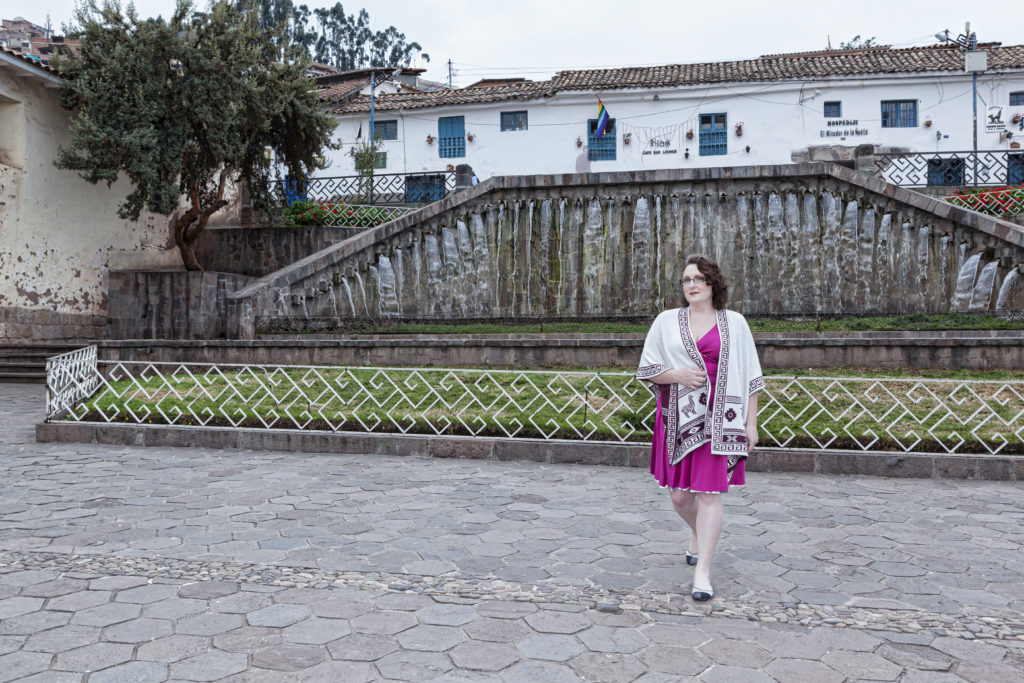
Fountain in San Blas 
Fountain in Cusco 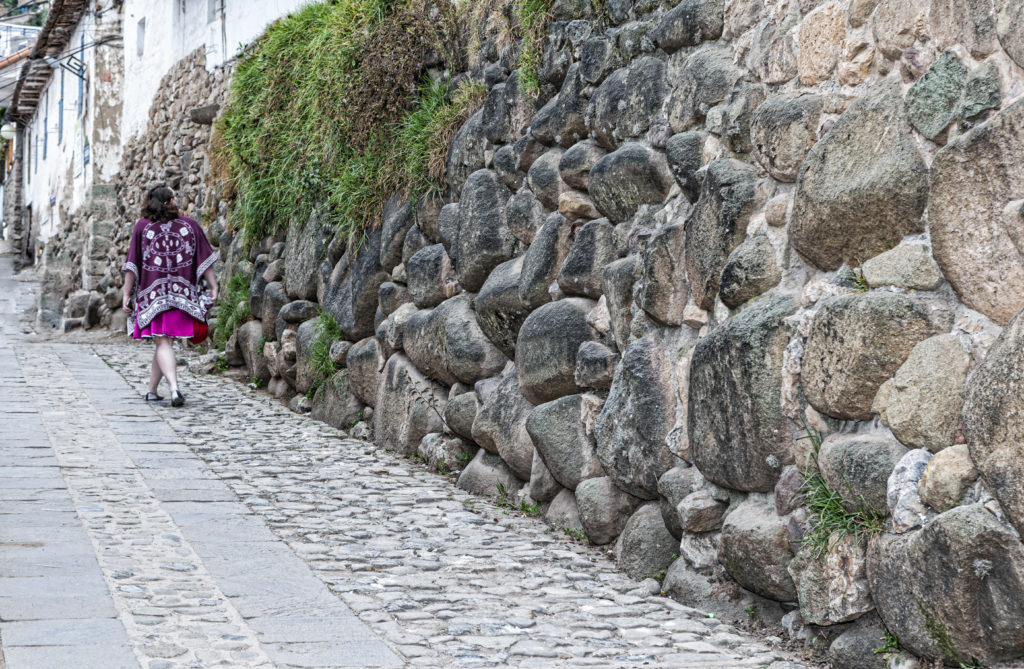
Stone walls 
Shopping
We ended the photo walk in the town square, where the day’s parades were just getting started. It seems parades go from 8:30 a.m. until well past when I’m asleep, for the entire month of June. It makes Cusco seem like an endless party, and it’s a really nice vibe. But we leave the parade to take a taxi back to the photographer’s studio and select which photos he’ll edit.
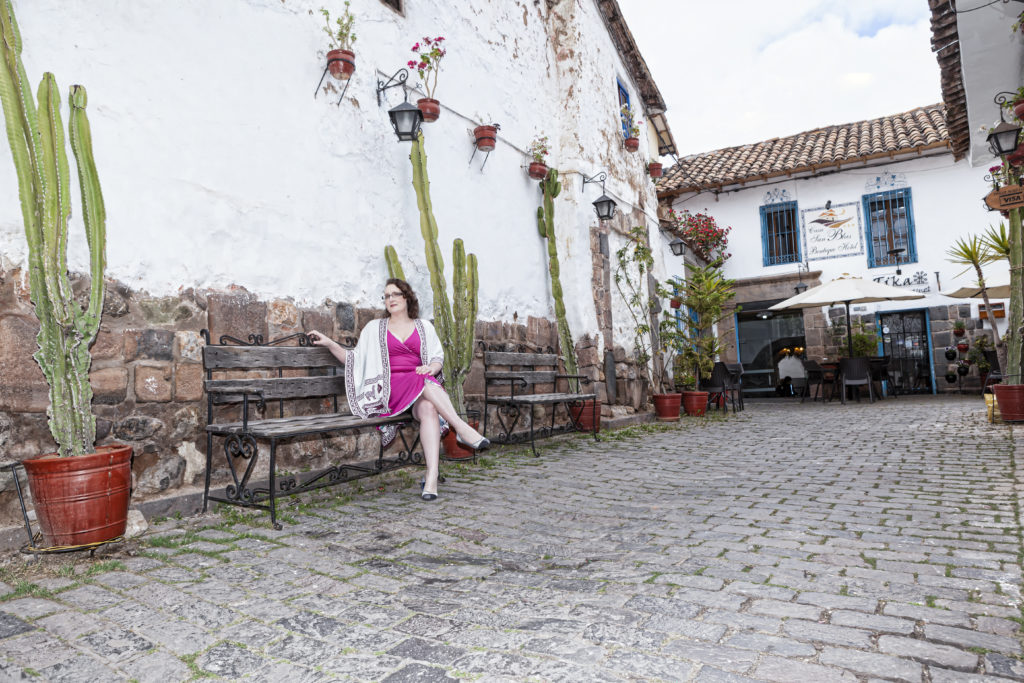
A beautiful alleyway with a restaurant 
Narrow street with mountains 
Town square with cathedral 
Qorikancha 
Sacred Garden looking out to Qorikancha 
Another beautiful overlook
Lunch
After we selected all of the photos, I chose to walk back to town, rather than taking a taxi. It’s a 1.5 mile walk, but through a new neighborhood, so I go for it. Tons of cool looking restaurants and actual local shops (not selling alpaca sweaters). There was some sort of bicycle parade going through this neighborhood and lots of streets were blocked off. People on bicycles were riding down the streets with balloons tied to their bikes.
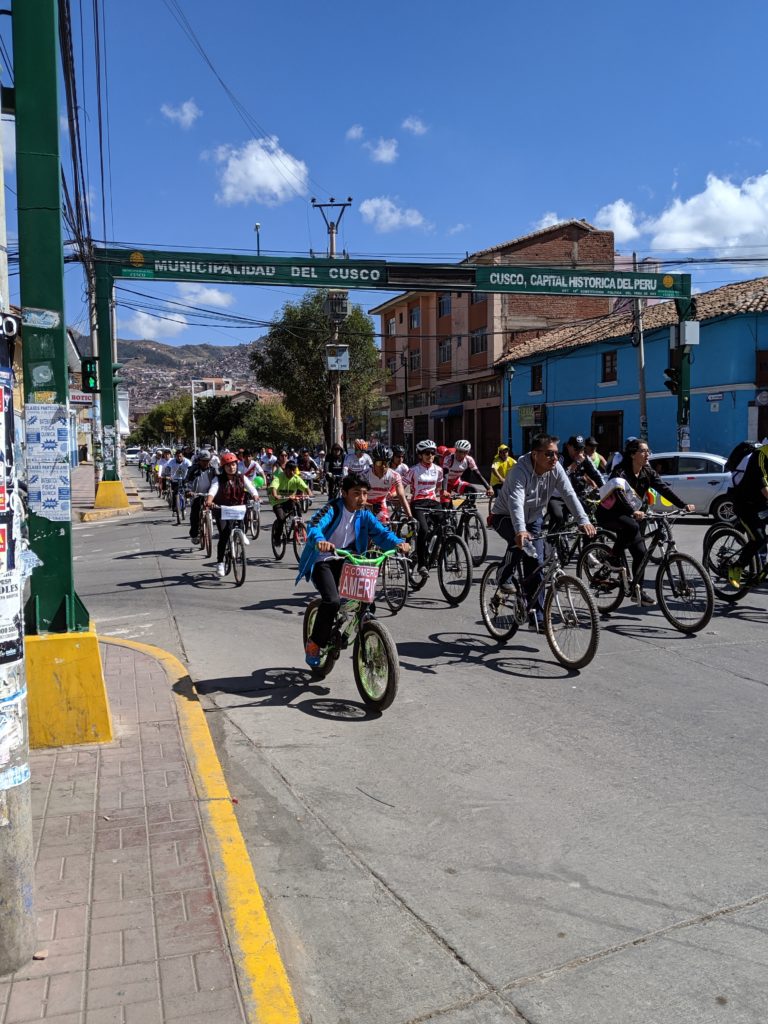
Bicycle parade 
Me and a bicycle
Finally, I got back to the town square. I only have an hour or so before my afternoon city tour, so I needed to find lunch. But also, I wanted to watch the parade. Today’s parade is very different from the one last night. Last night, it was all fancy dress and party time. Today, it’s more cultural. Each village and area around Cusco has a specific type of traditional dress. And they are parading through town in these amazingly detailed vibrant outfits. Apparently, the most accurate way to determine which village a person is from is from the hats, as those are the most distinct. But I know nothing about the villages, so I just watch and let the parade of colors and embroidery wash over me. The scale of it is absolutely overwhelming. There are so many people, and these costumes are so incredibly detailed and layered. It is absolutely impossible to fathom the infrastructure of textile work that culminates in this gathering.

There are so, so many people in these folk dresses 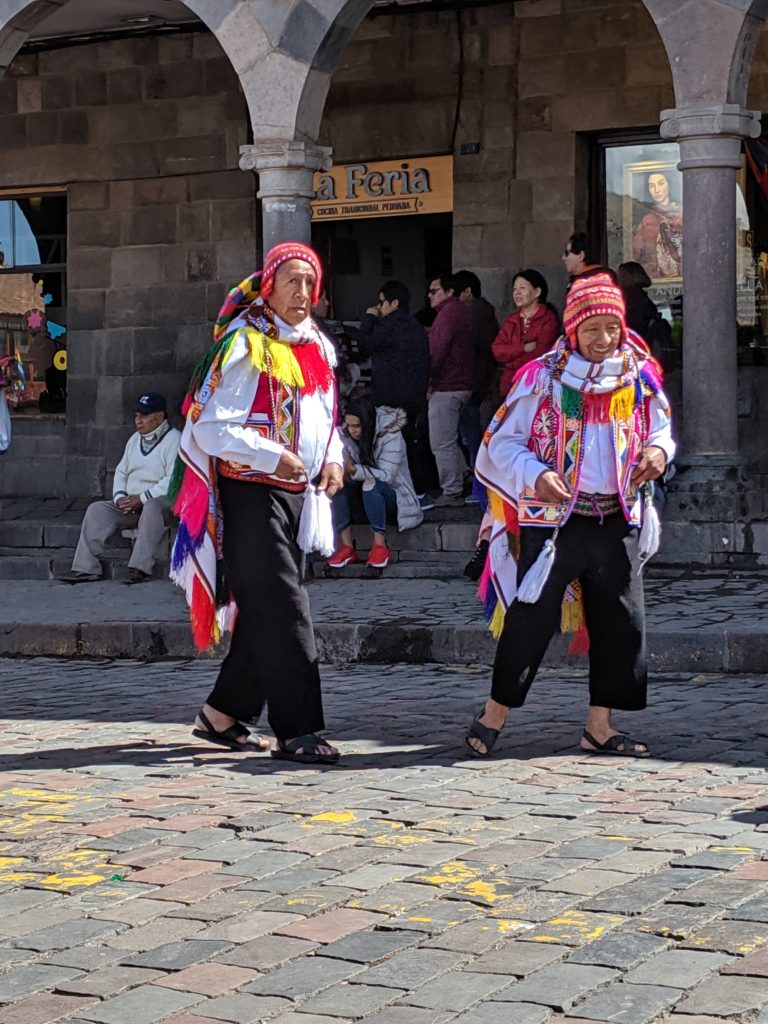
And so many layers 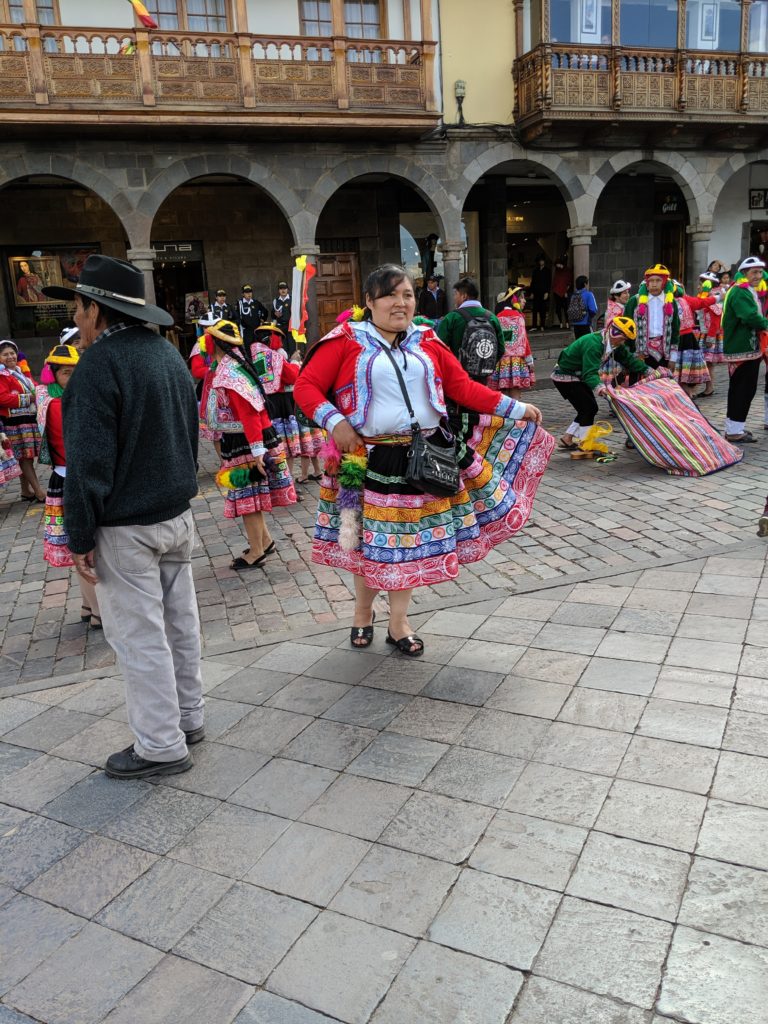
Just beautiful and so colorful 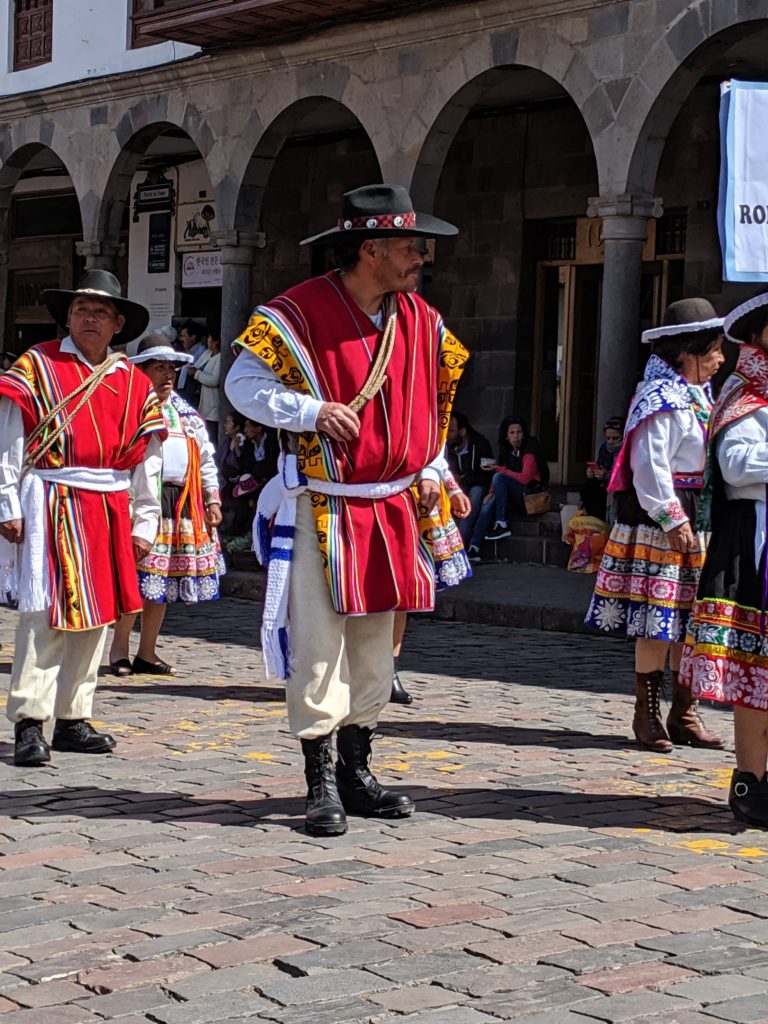
Intricate colors of ponchos 
Ladies dance with these strings of pom-poms 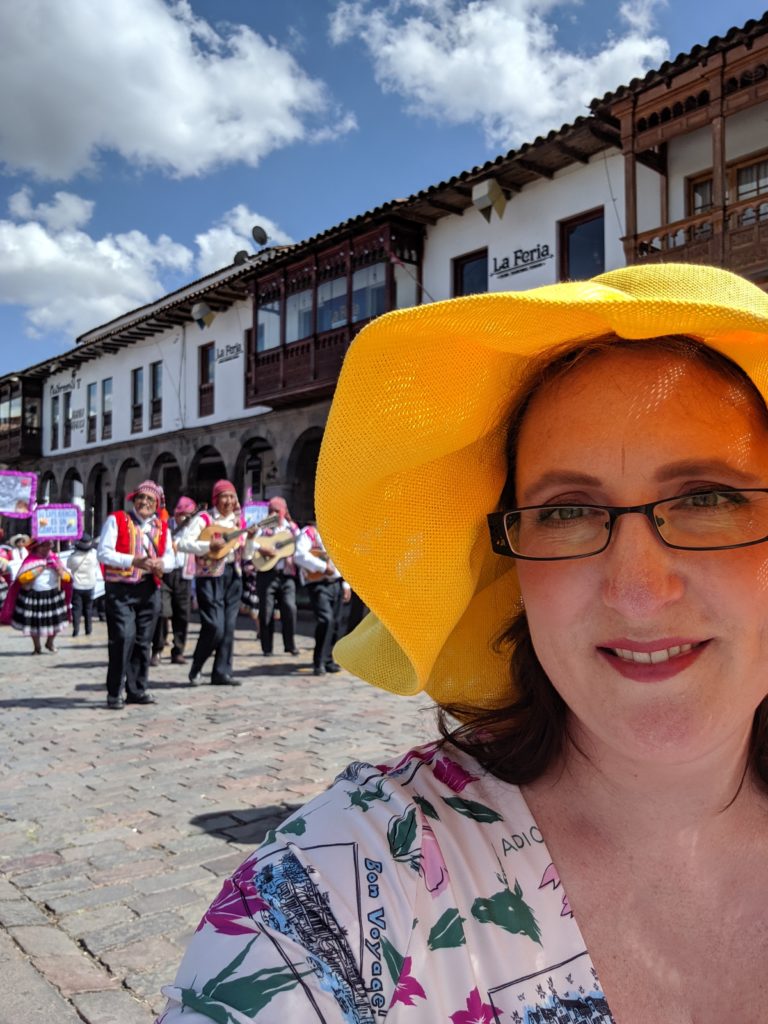
It looks like this whole band is serenading me
While I am walking around looking for a place to have lunch, hoping to find a place with outdoor seating so I can watch the parade while eating, one of the guys on the street with menus implores me to come to his restaurant. “Balcony” he says. Ok, so I go to the tourist restaurant. I don’t have time to really analyze all of my options, and this is easy and I get to watch the parade.
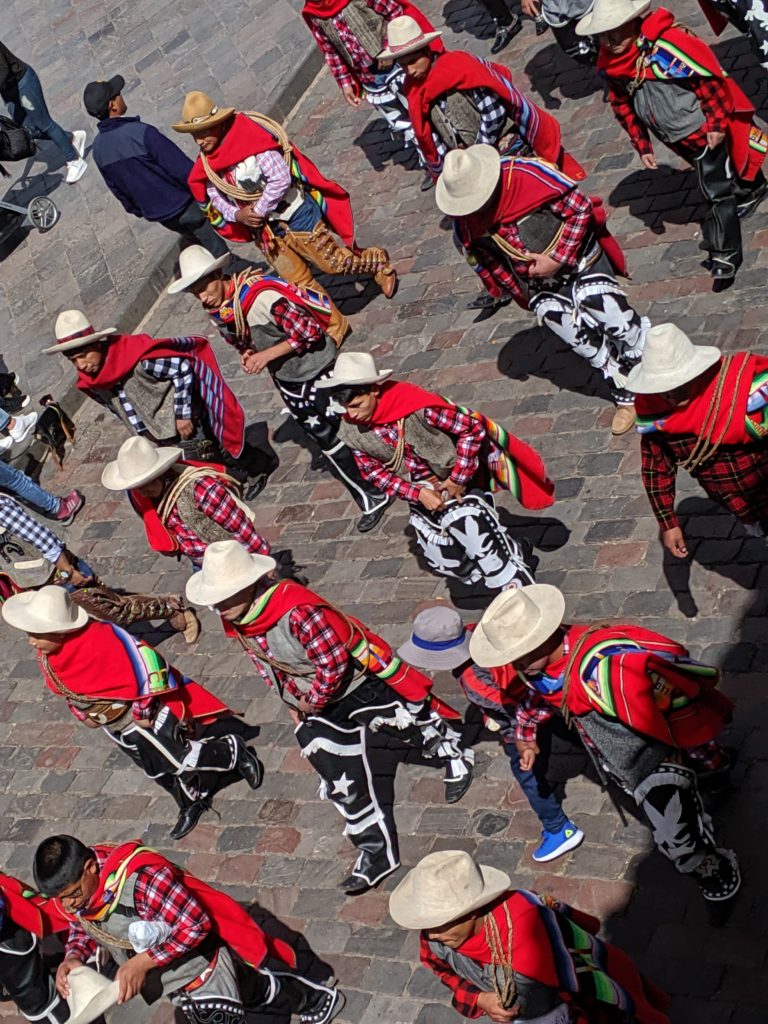
Birds eye view from the balcony 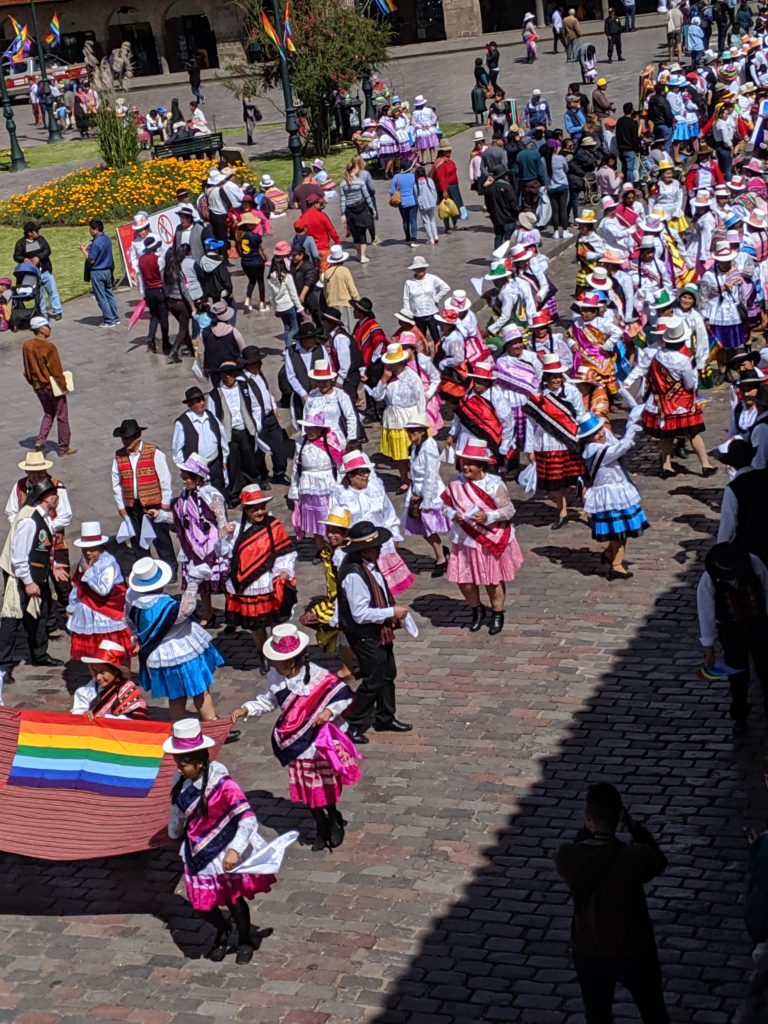
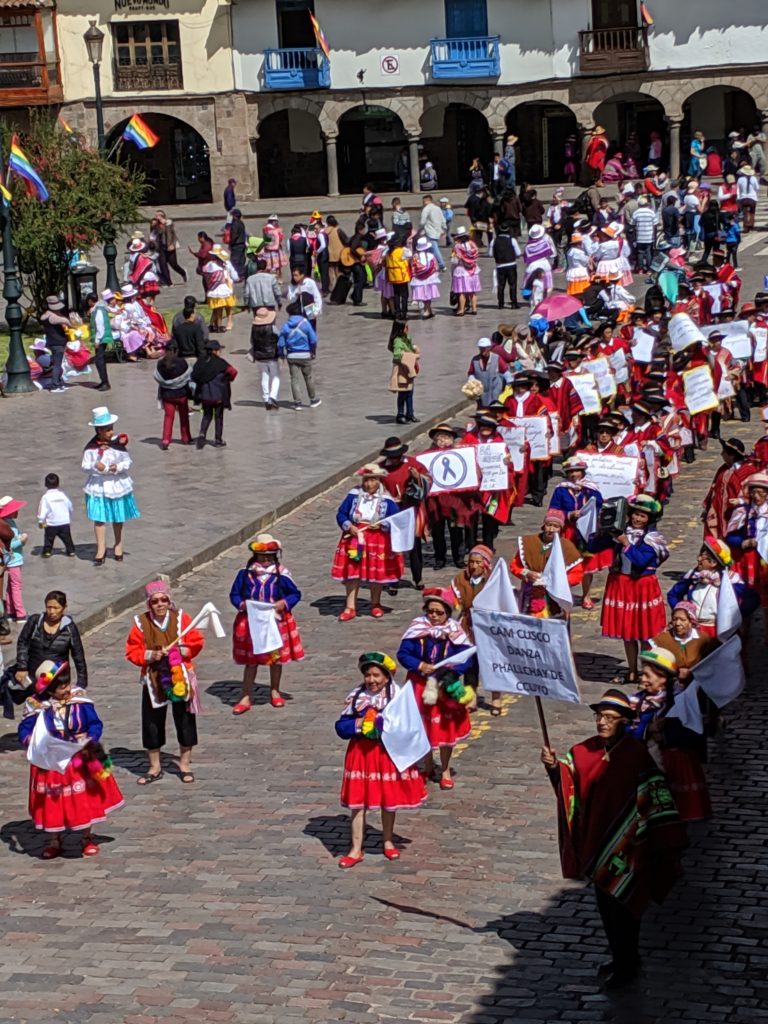
In the end, this wasn’t really the best idea. I ordered fried pork and a bottle of water. The waiter brought me a bottle of water, with the lid already removed before he came to my table. Hmm, ok. The food was ok. Fried pork with fried potatoes, a little salad, some delicious local bread (though a bit stale), and a sweet tamale full of raisins. But the service was very slow, and when I asked for the check, the waiter brought it out and sternly said “Service is not included”. So I pay and go back to my room and get a full bottle of water, before meeting my afternoon tour guide.

Lunch on the balcony 
The view of the town square 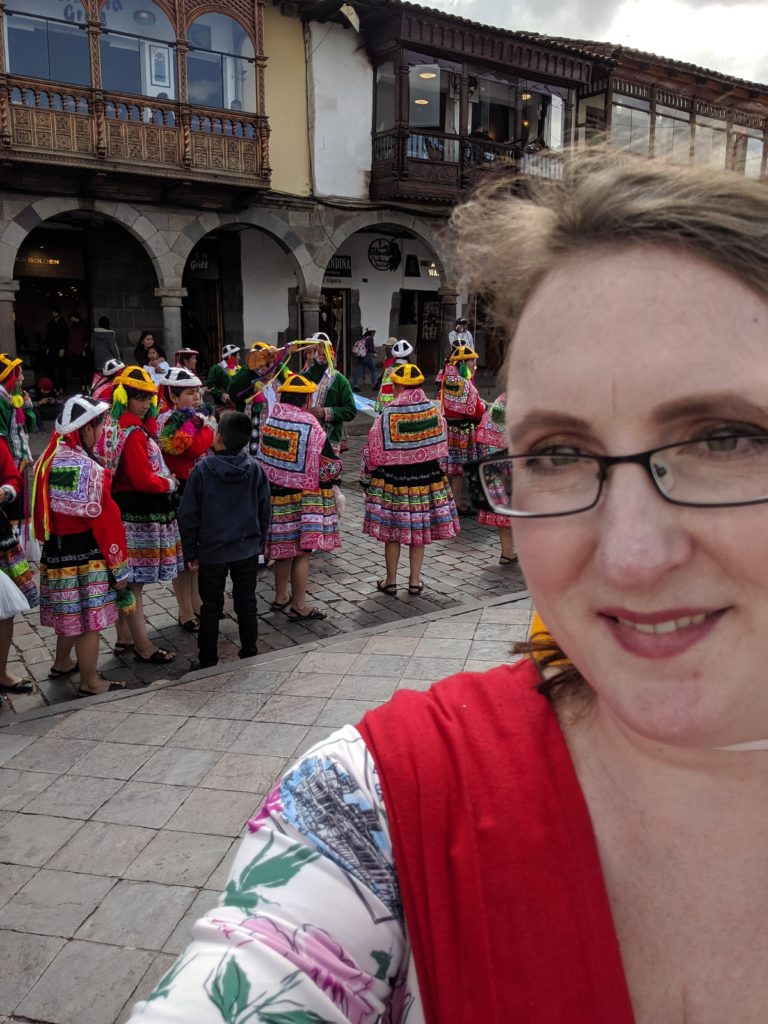
More fun costumes 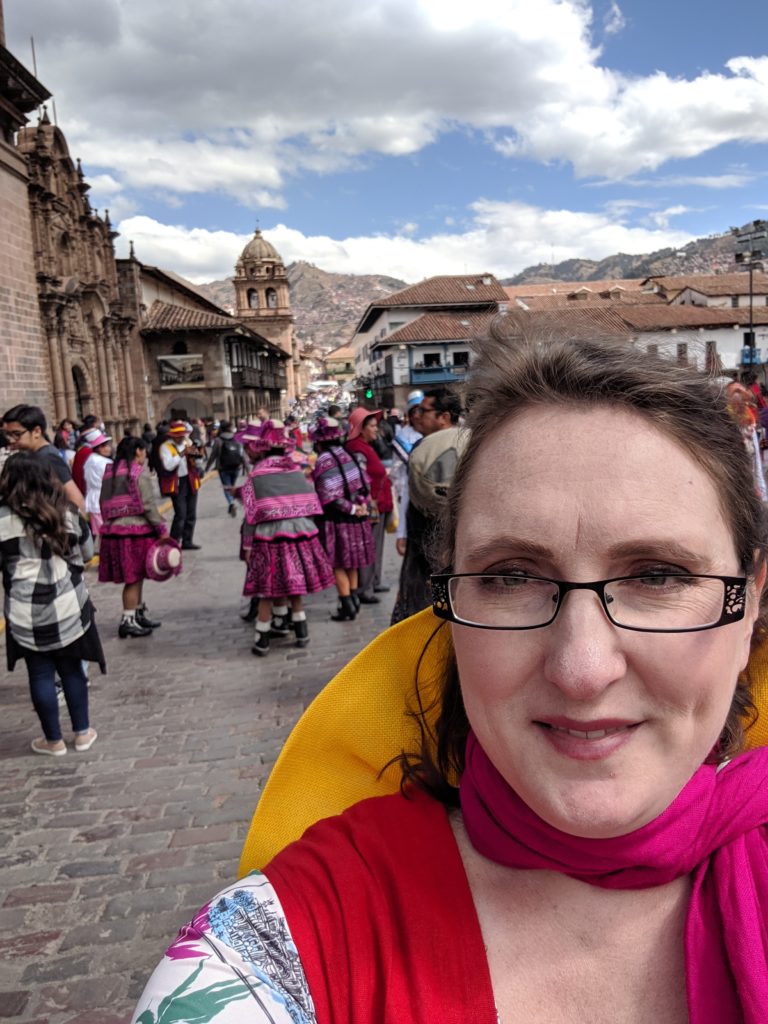
Walking back to the hotel 
These ladies are wearing velvet with intricate cut-outs over black fabric. It’s beautiful, but must be a million degrees in there 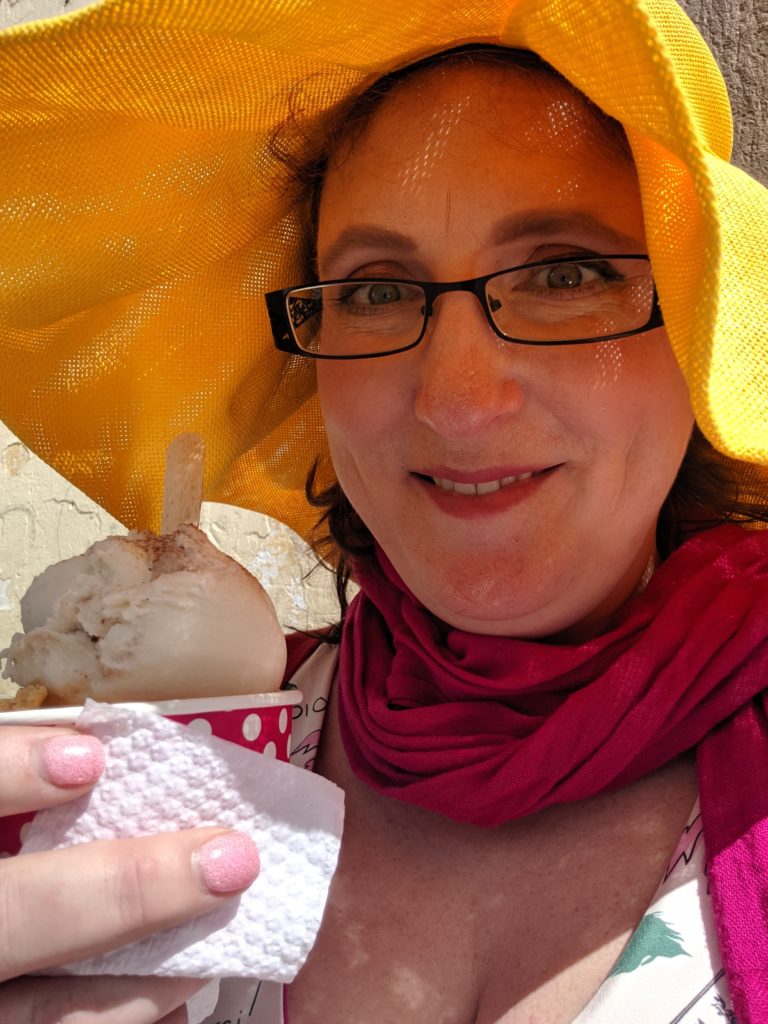
Stopped for a quick ice cream – bottom scoop (in cup) is Lucuma, and the top scoop is Queso flavored.
Cusco City Tour
At 1:30, my tour guide arrives and we get into a van for our tour of the city. The tour guide is Joanna, and she is petite, sporty, and stunningly beautiful. She is also no-nonsense, and very direct. I like her immediately. We drive for about half an hour out to our first stop, Puka Pukara, an Incan era fortress. I learn that ‘puka’ means red, and ‘pukara’ is fortress. The stones are a light pink granite, but perhaps it was more red in its day. This is my second day in Cusco, at altitude, and this fortress is, naturally, atop a nearby mountain, so we have actually increased altitude from Cusco city. Joanna is very patient and slowly ascends the stairs into the ruins so I can keep breathing. The ruins at this site are mostly short walls, without a lot of detail left to observe. But the view from this high point is stunning. Just looking out over the city of Cusco, at the mountains and the clouds. And have I mentioned the weather was just so very perfect every second of my entire trip? The thin air feels cold as you breath it in, but the sun is warm (and I’m wearing SPF 70 on every exposed inch).
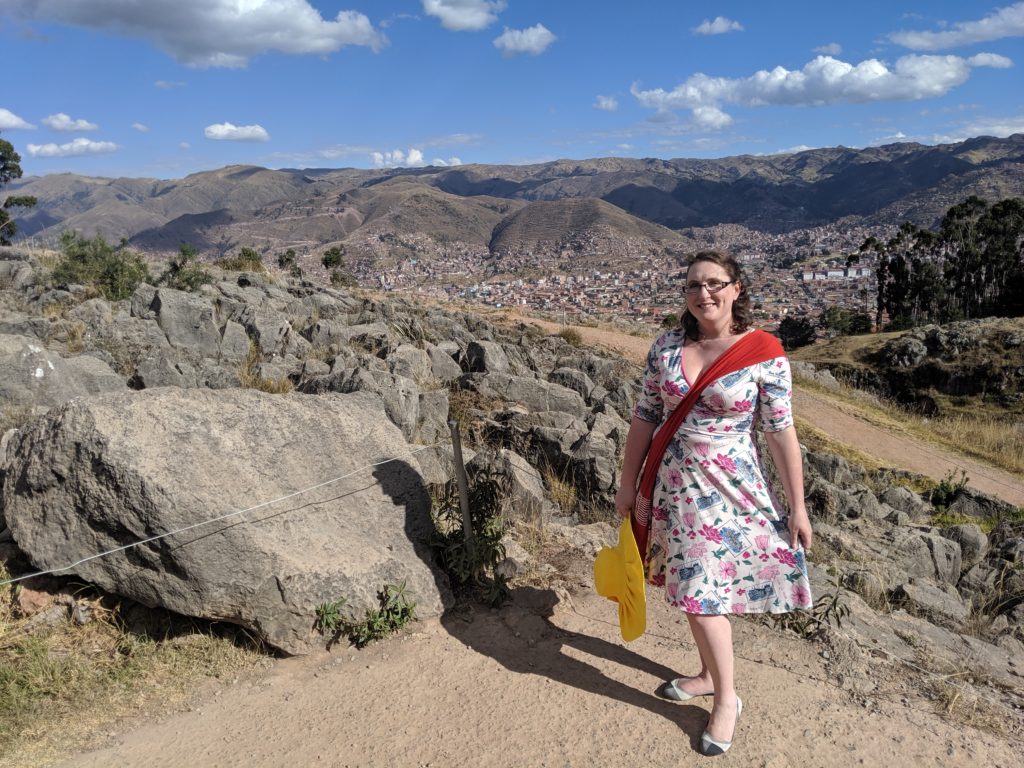
The view from the top 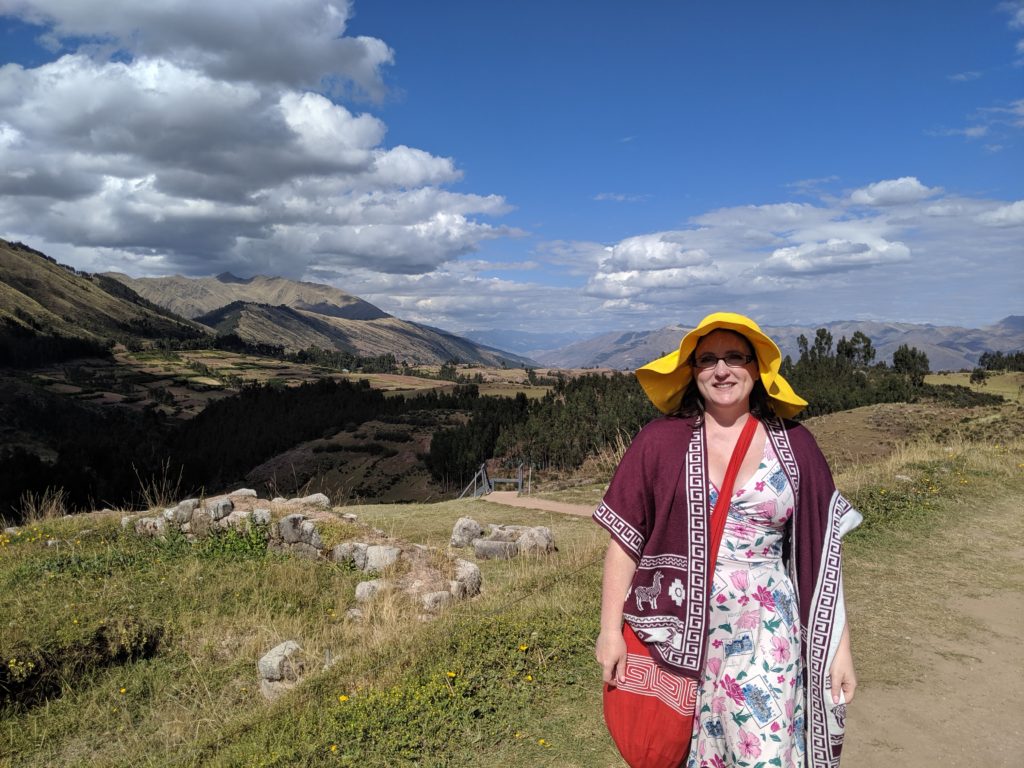
Beautiful vistas
From there we go to Q’enqo ruins (pronounced Kinko, like the print store). This is one of the huacas, or sacred sites, around Cusco. We walk through stone paths, learning about the mythology of the Incas. The condor represents the upper world. The puma represents this world, and the snake represents the underworld. When an Inca king or important person dies, they are taken to this site, into a little carved out cave, for the mummification process. There’s a prep table, and squares cut into the walls for storage during the drying process. Then, the condor takes the soul from the underworld to the upper world. The rocks on top of these ruins apparently make the shape of a puma with their shadows during the winter solstice. However, due to people falling and injuring themselves, it is no longer allowed to climb up to the top to see them.
Our next stop was Tambomachay, another huaca, that is a water temple. Here, we learn about the incredibly complex irrigation system that the Incas used to supply water to all of the people. We also discuss a bit more about the Incan Empire. I learn that Inca was just the word for ‘king’, not the name of the people within the empire (but for here, I’ll just say the Incas, as I don’t know the actual word for the population). While the Incas formed their vast empire through conquest, they are mostly remembered fondly (through the people I have talked to). People still speak Quechua, the language of the Incas, though there was no written language, so all Quechua is transliterated by the Spanish into the Latin alphabet, making it very easy to sound out and read Quechua, as Spanish is very phonetic. But the stories I am told of the Incas is that they conquer people, but then take in the knowledge of the people they take over, and spread it throughout their kingdom. They often elevate the best craftspeople and artisans and bring them to major cities so they can train others and share their knowledge. They were, of course, brutal to those to refused to be conquered, and there are still tribes that are very bitter about the general glorification of the Incas. However, most everyone agrees that the Spanish were assholes (my words, not theirs). The Spanish came and ‘discovered’ all of these things, and decided that these people were dumb savages and just weren’t doing it right. So it is with some amount of delight that my tour guides over the coming days explain to me how the Incan ruins are still standing, giant rock walls, unswayed by time and change, while the buildings the Spanish built have needed to be reconstructed after ever earthquake. This sounds pretty much the way I would have imagined it.
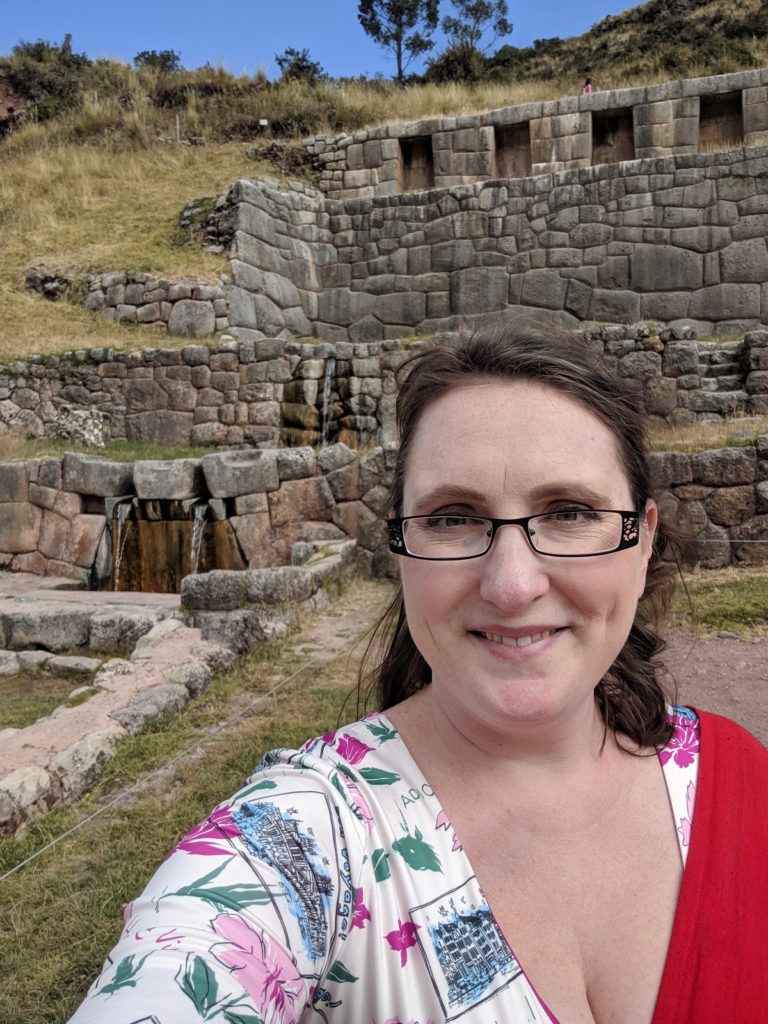
Beautiful fountain – niches in the top terrace were for statues
Anyway, the water temple is beautiful. Ice cold water comes from underground springs at the top of the mountain and flows through the temple’s fountains, past niches that used to hold idols. I’m not sure if it’s the elevation or what causes it, but the smell of the earth and the water and the trees is very intense up here. Perhaps having all of those organic compounds under a vacuum increases their concentration? Or maybe it’s just that I’m breathing so much faster than normal to get oxygen.
After the water temple, we went to our final Incan ruins of the day: Sacsayhuamán. You will hear plenty of dumb tourists giggling about ‘sexy woman’. But it’s pronounced more like ‘socks eye h-woman’. Anyway, ‘sacsay’ means zig-zag (if we trust Joanna and don’t think she’s pulling my touristy leg 😉 ). And sure enough, it’s a giant zig-zag. This was a place used for grand ceremonies. It’s a huge open field with ruins on either side. The zig-zag side of it had 3 giant towers overlooking the valley, monitoring the trails that go into and out of Cusco. Cusco was the capital of the Incan Empire (the Spanish moved the capital to Lima because it’s a port city). Many trails pass through Cusco. There were no horses in South America before the Spanish, only the llamas and alpacas. Llamas are bigger, and can be used to transport things, but aren’t big enough to ride on. (Alpacas are used for wool and meat only). So the primary mode of transportation was walking. So presumably it was pretty easy to keep an eye on who was going where from the top of the tower, since they weren’t moving terribly fast. On the winter solstice (in a couple of weeks), there will be a huge celebration of the sun god, Inti. So they are preparing the field for this now.
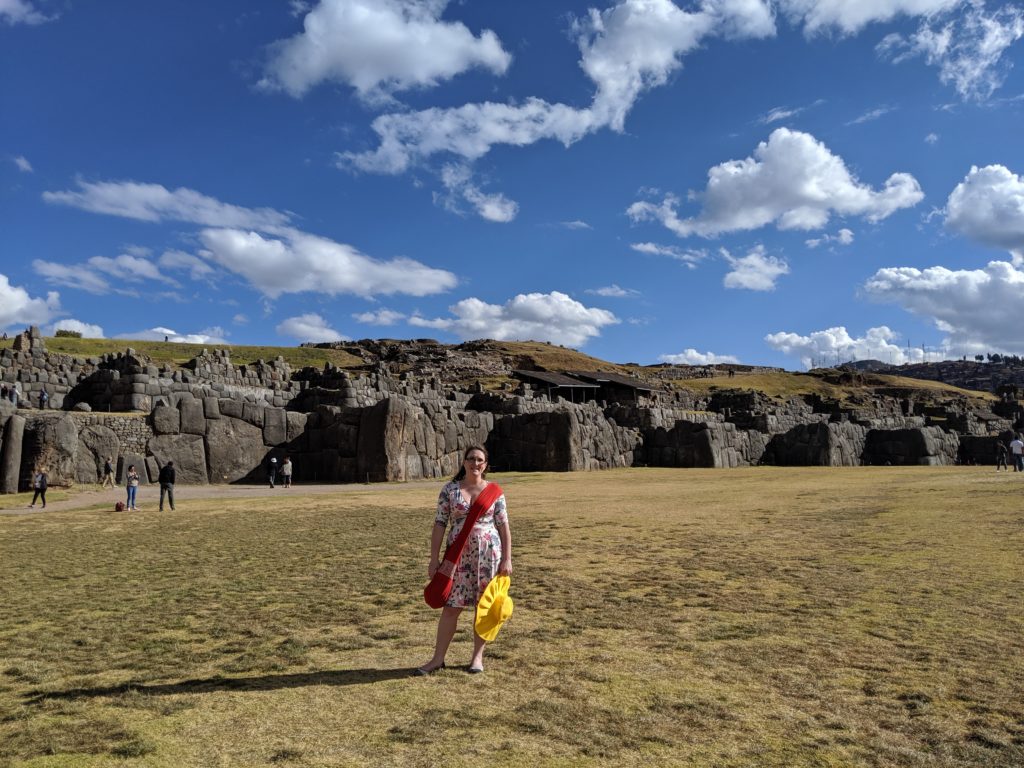
Great view of the zig-zags 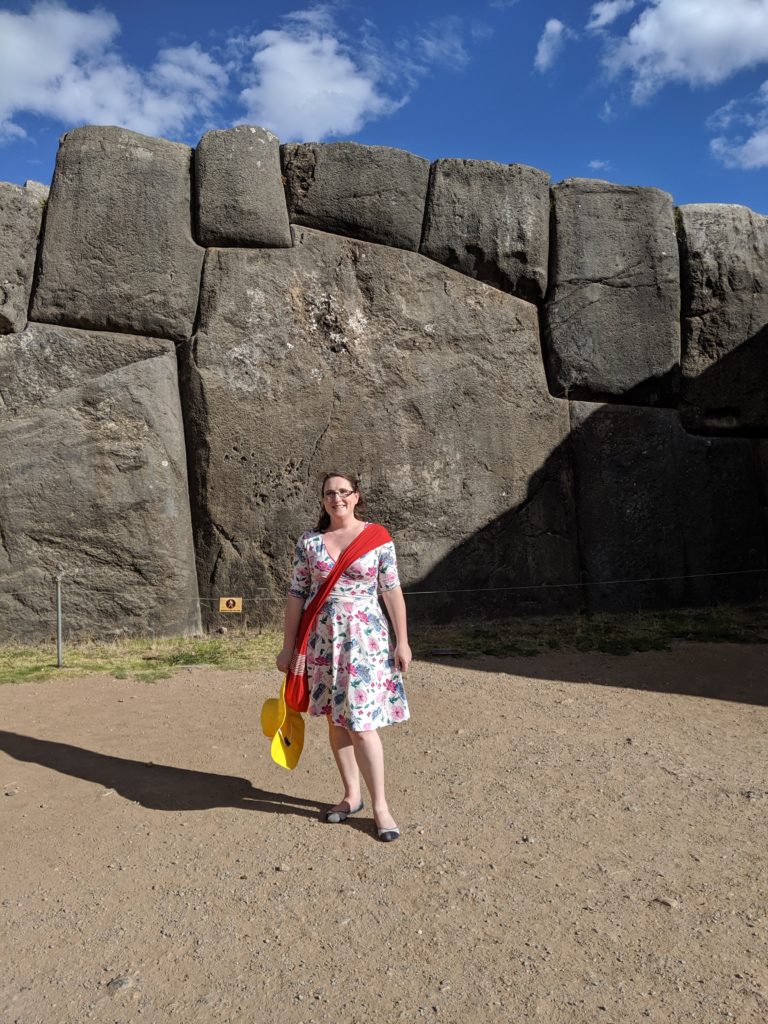
These huge stones had to be moved here and carved to the proper shape – also they have like interlocking parts inside, like legos 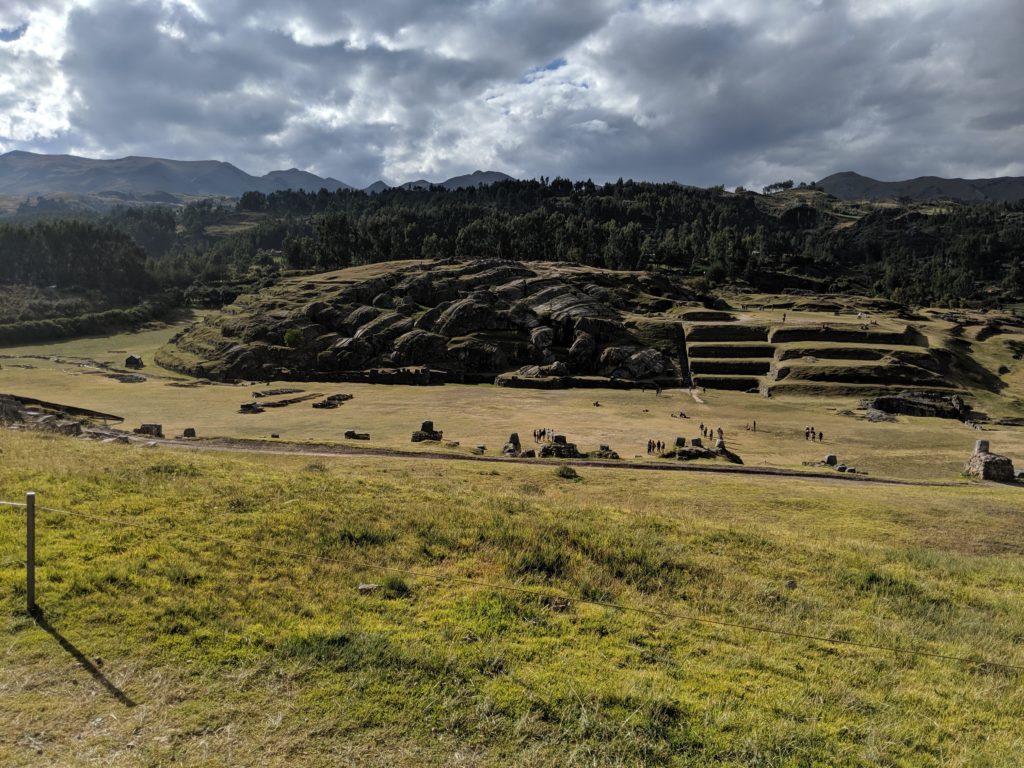
The view from the top of the zig-zag over the field 
The view of Cusco city 
Under the zig-zag
After the ruins, we go back to the main square of Cusco and visit the Cathedral. No photos are allowed inside, so I can’t show you any of it. But suffice to say it is full of gold and riches and paintings and carvings more ornate than anything I’ve seen in any European church, and almost as ostentatious as Russian churches. But also the Spanish forced the people of Peru (and most of South America) to convert to Catholicism. I even learned how many of the stones used to build this cathedral were taken from Sacsayhuamán. And did the Spanish do this themselves? Of course not. They enslaved the locals and forced them to dismantle their own temples and build a church. Anyway, It was a pretty sickening display of arrogant colonialism, and if I had known the Catholic church was part of the tour (and they they sell tickets), I would have opted out with the tour company beforehand. There is no institution on this earth that I’d rather give less of my dollars to than the Catholic Church.
From there, we went to Qorikancha. This is a beautiful temple on the edge of a cliff, overlooking Jardín Sagrado, or the sacred gardens. This is a strange and interesting spot because there are a lot of Incan ruins left, with temples to the sun, the moon, and lightning. Lots of interesting architecture and artifacts are here. But also, it was converted to a Catholic church at some point as well, so just inside the Inca walls, there is a Catholic church. I am told that this is because, after the earthquake destroyed many of the Spanish buildings, the Spanish decided not to destroy these Inca walls, as they survived the earthquake, and build their church inside the already existing temple walls.
Pisco Sour Lesson
After Qorikancha, which is across the street from my hotel, I said goodbye to Joanna and settled in for the night. One of the things I didn’t know about the altitude was how hard it would be to sleep. Last night, every time I start to drift off to sleep, my body does that jumping thing, where you dream you’re falling off a cliff or something. I think, as my heart rate and breathing slowed for sleep, my brain was like “NOT ENOUGH OXYGEN!” and so my 2 nights in Cusco were absolutely fitful sleep. And before that, my night in Lima was short as I had to get up early to catch a flight. And before that, I had landed at 6 a.m. after sleeping on a plane. So I’m exhausted and as much as I’d love to go back into town and watch the parades, I just decide to enjoy with fancy schmancy Marriott Autograph Luxury Collection Hotel: Palacio del Inca.

My strawberry pisco drink
I begin my relaxing evening by going to the hotel bar for the Pisco Sour lesson at 6 p.m. It’s only 5:15, so I take my laptop and order a strawberry pisco sour to enjoy while I wait. At 5:15, I am the only person at the bar, save one man drinking gin-and-tonics. But by 5:40, there are gaggles of white women everywhere. If you are in Cusco and you want to know where the ladies at, this is it. A group of 6 women sit to my right and order 2 bottles of white wine to start their evening. Go off, Jill. To my other side, mostly couples, with the woman clearly dragging the man along to this lesson, populate the bar stools. It gets completely full (there’s a 20 person limit), so I’m glad I came early and got a seat.
The lesson starts and it’s actually super informative. We learn about Pisco as a liquor, what it’s made from, and the types and quality of each type. There are different types of grapes, 6 in total, but primarly Quebranta and Italia grapes are used for pisco making. Then there are types of pisco. Puro, or pure, is made from a single type of grapes. We are told that Pure Quebranta is the best pisco for cocktails and pisco sours. The next type is Achelado, which is a mix of the types of grapes used. This is good for sipping neat. And finally, the fanciest is Mosto Verde, which uses the largest amount of grapes per liter of pisco, and this should definitely only be served neat. Then we get to the lesson of how to make it. 4 oz of pisco, 2 oz. lime juice, 2 oz simple syrup, and a splash (about a teaspoon) of egg white. Put in a shaker (or a blender, as the Marriott does), shake or blend until foamy, then pour over ice. Stir with the ice until cold, then strain into a glass. Finally add a drop of angostura bitters on top. The fancy Marriott uses a bottle of bitters with a toothpick in the top, so you can write with it. And the write a letter L on the top of their pisco sours. L? Oh that stands for ‘Luxury’ since this is a ‘Luxury collection’ hotel, and there are all of these experiences you can have here. (Did I mention I am staying in a ‘Colonial Suite? Very nice and yet ironic room upgrade)
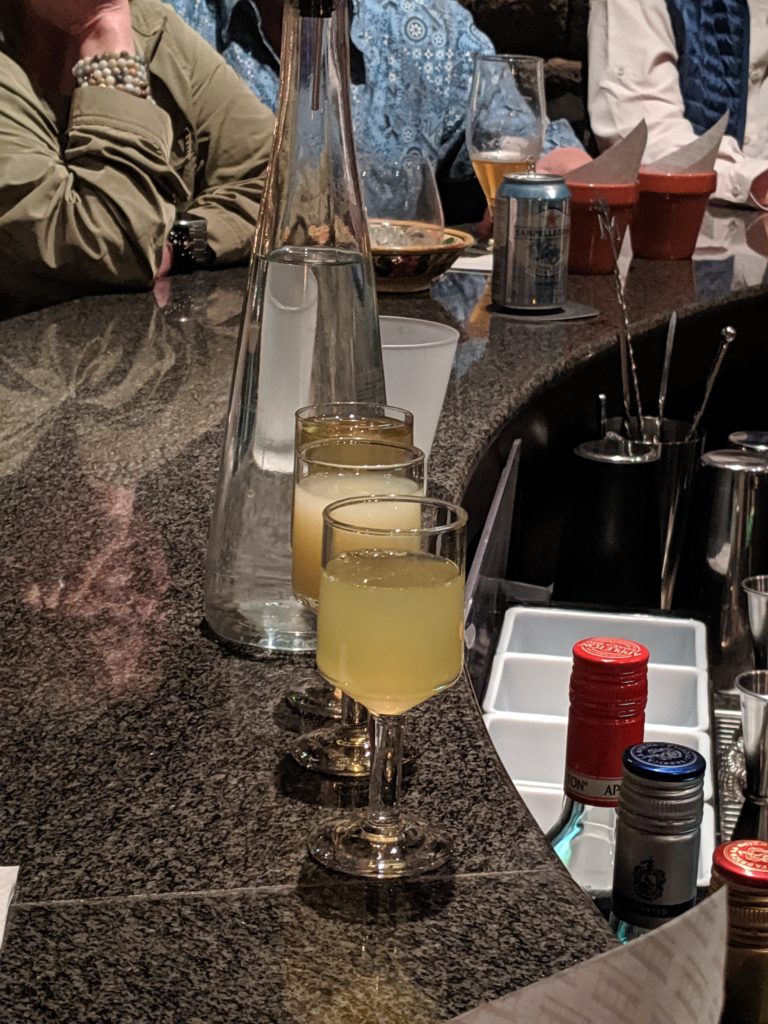
Ingredients for pisco sour: pisco, simple syrup, lime juice, and egg white
After the lesson, they have made one full size pisco sour, and they made a pitcher of pisco sour to pour into small glasses for everyone in the class to sample. Now, the teacher guy is like “I’ll give the big one to anyone who can answer my 2 questions about the class.”
Bartender: ‘Who can name the 2 kinds of grapes used for pisco?’
Me: don’t raise hand. don’t raise hand. Don’t be a nerd for like 5 minutes.
Everyone: …
Me: Seriously, you’ve already had a full size drink. You don’t need more at altitude.
Everyone: …
Me: raises hand.
So yay, I won the full-size pisco sour by remembering that paragraph above! Also, I have made for myself a spa appointment at 6. So like, I have 20 minutes to drink this whole pisco sour. I’m so glad I’m a smart person 😛
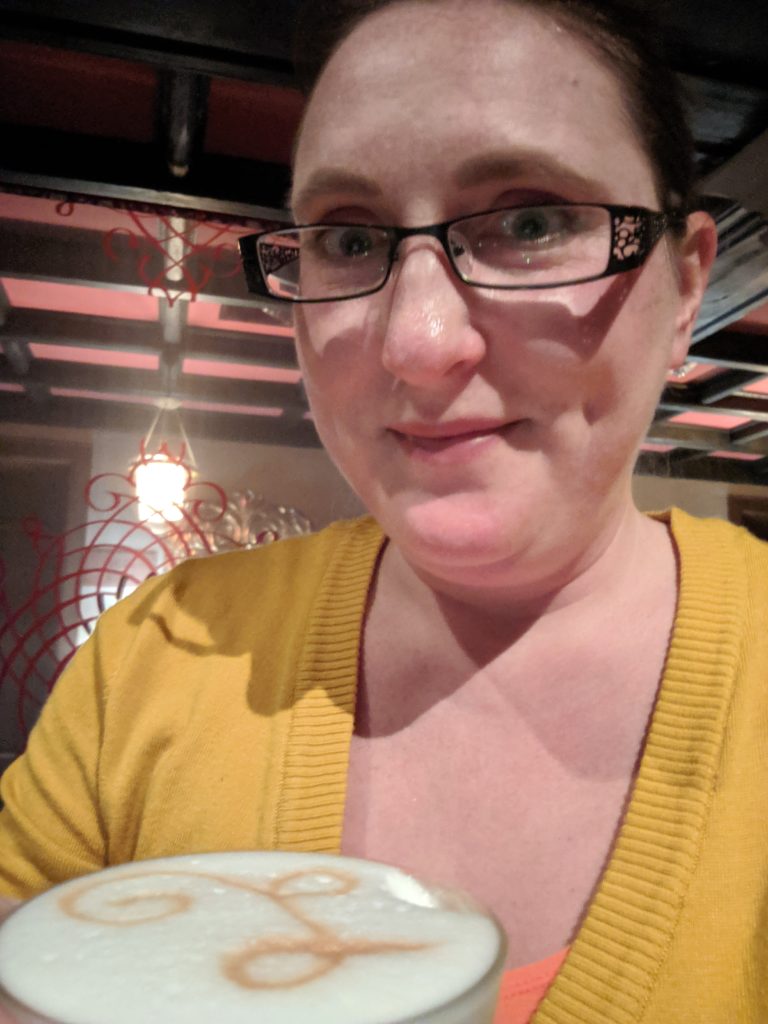
My luxurious pisco sour 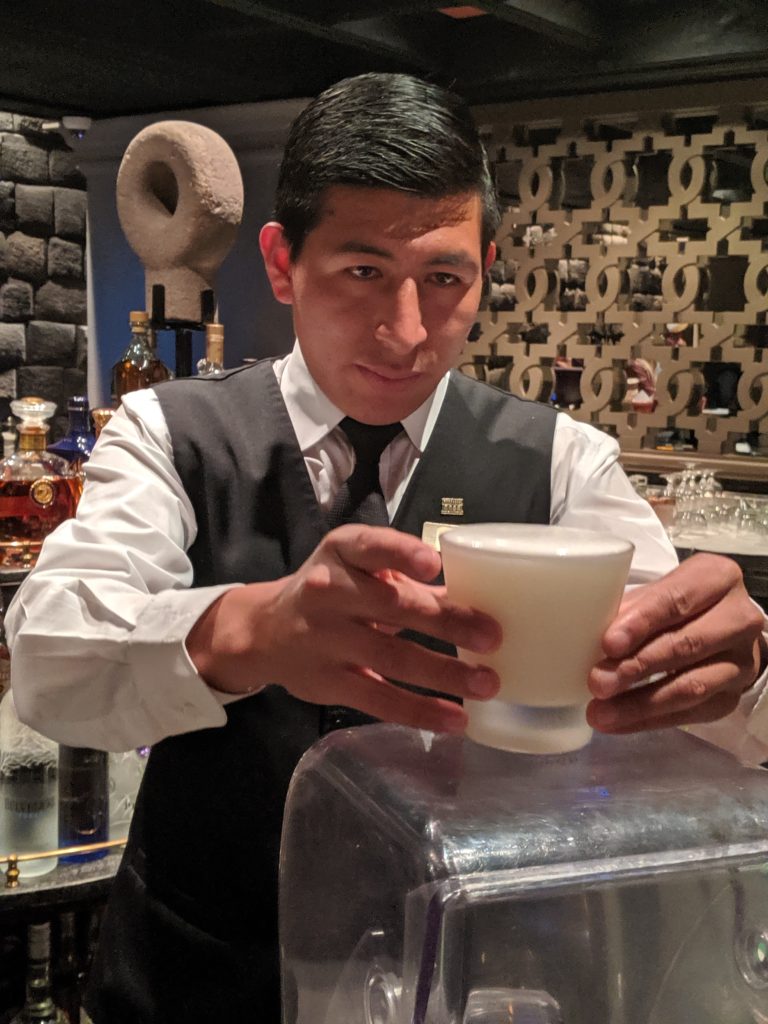
The bartender 
I took a sip before I took a photo…. my bad
Spa
After all the walking around the past few days, I have made myself a reservation at the hotel spa. They just opened a new water course, and it’s the special for the month, so I give that a try. The water course consists of a warm pool, with different areas of jets to massage different muscles. First, there’s a bench in one corner, where the jets massage your calves and feet. Then, the next corner houses a couple of waterfall type implements for pouring water over your shoulders for a shoulder massage. Then, there are chairs for a full body massage. Finally, there’s a hot tub for relaxing.
I arrive just as another couple is leaving, so I end up having the room to myself for most of the time. The water course is fun, but I ended up spending way more time in the hot tub and just relaxing. The jets of the water course were the air jets, not water jets, so they’re like cold needles in the hot water. The hot tub was just bubbly and warm.
After the hot tub, I go to the multiple shower rooms, with different types of hot and cold showers. And then I go relax in the steam room for a few minutes. After an hour or so of relaxing in the heat, I make my way back to my hotel room.
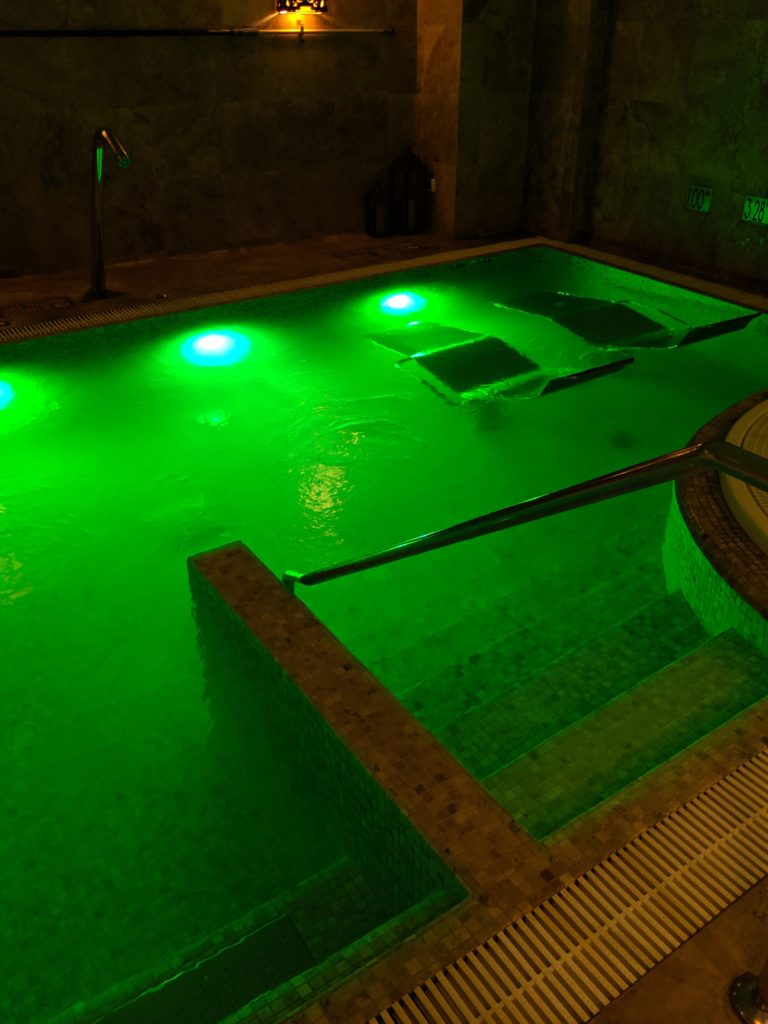
The water course 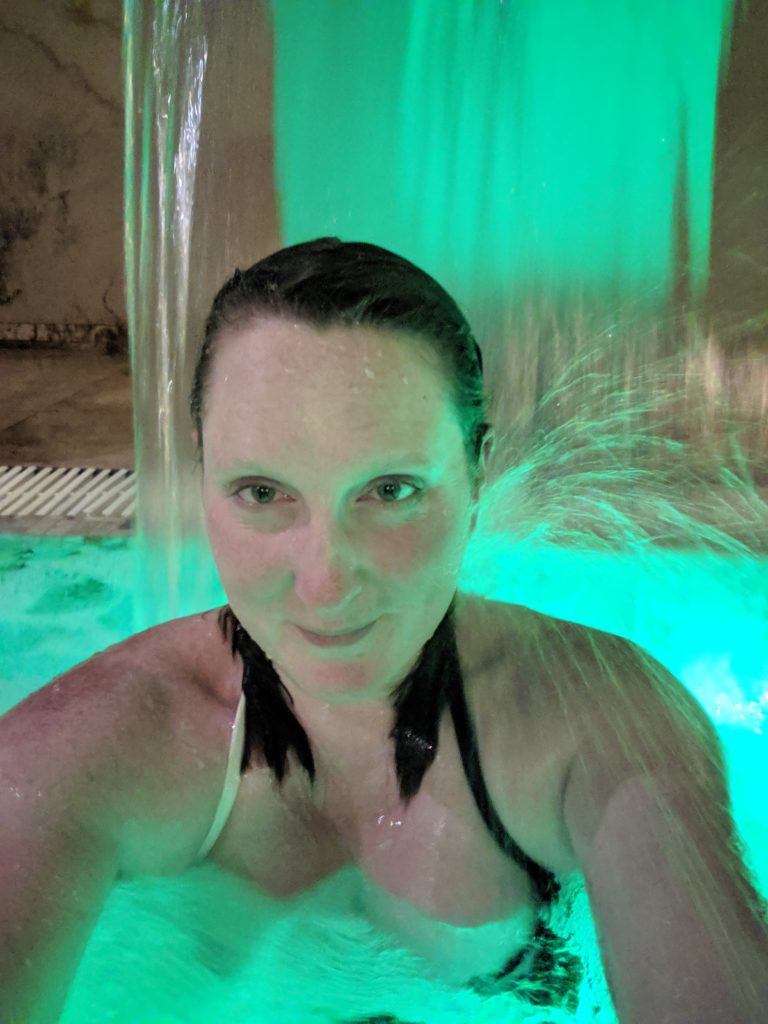
Getting a water-shoulder massage
Dinner
At this point, after 2 drinks and an hour of hot tubs, I would say I’m very relaxed, quite overheated, and a little dehydrated, on top of the aforementioned lack of sleep for the last several days. So while I had planned to get dressed and head over to the hotel restaurant for dinner, I just gave in to lounging in my room and ordering room service. Within 20 minutes, I have a Lomo Saltado Pizza, which is honestly one of the most delicious things I’ve ever had, along with a sprite to give my blood sugar a little jolt. After all of that, I get a good night’s rest because tomorrow is another early morning. My tour starts at 8, but I will be in a different hotel tomorrow, so I need to pack up and check out before then.
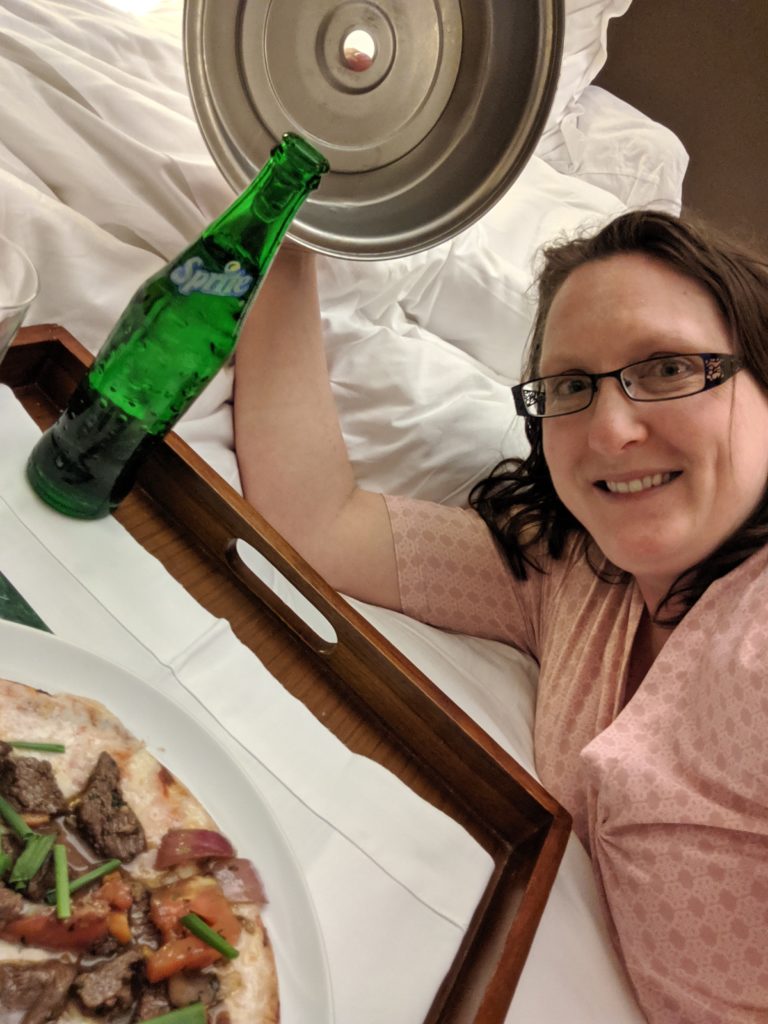
Yay! Room service 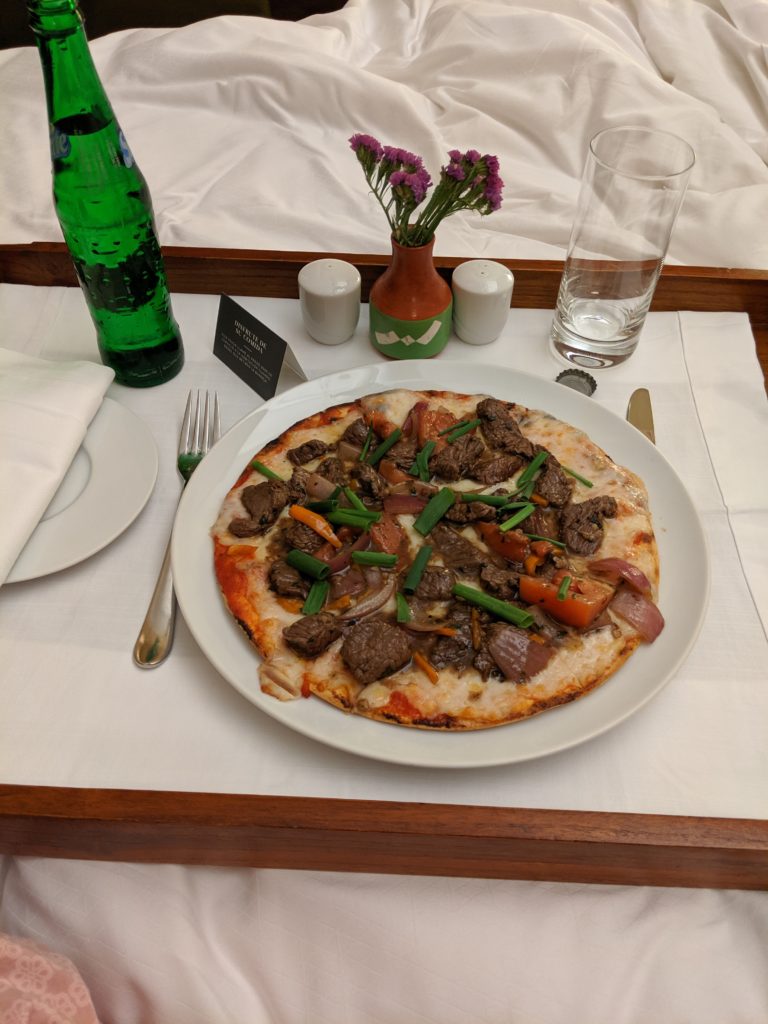
Lomo saltado is like steak tips, with onions and tomatoes. Delicious on pizza
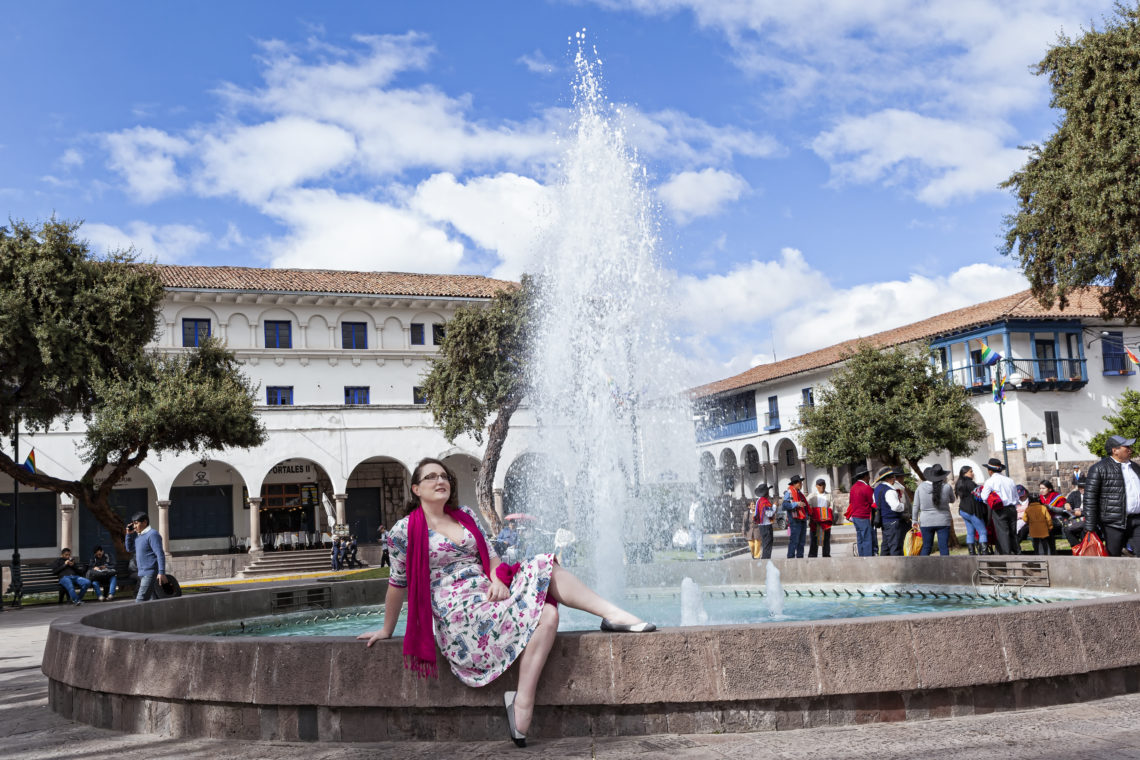
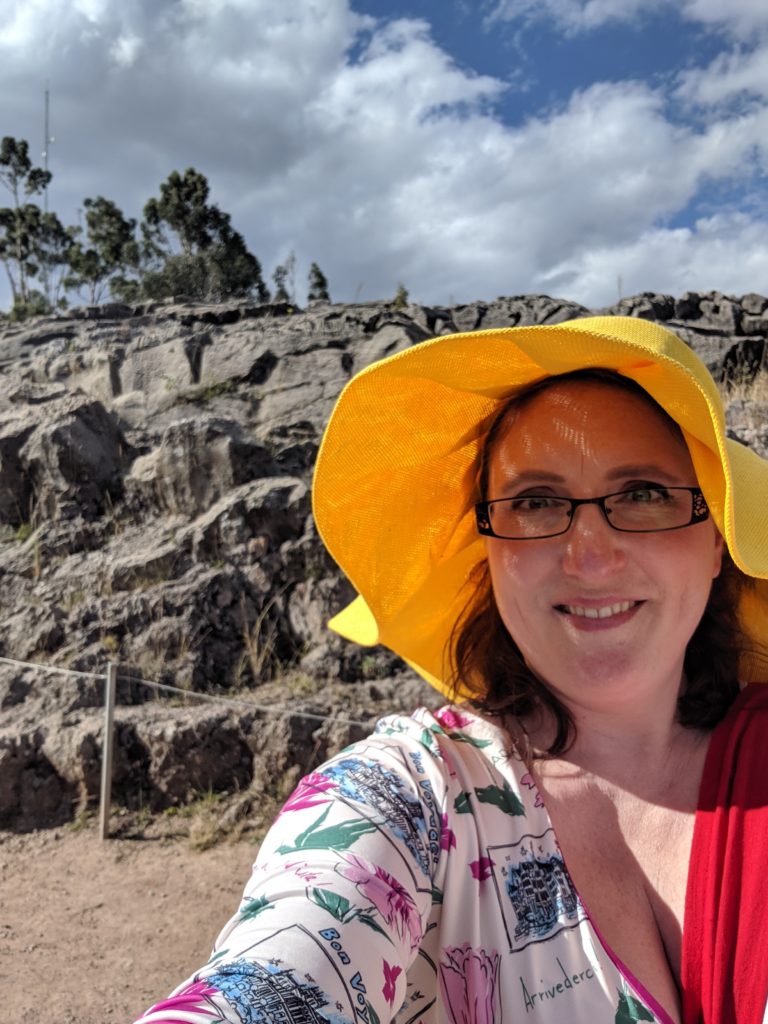


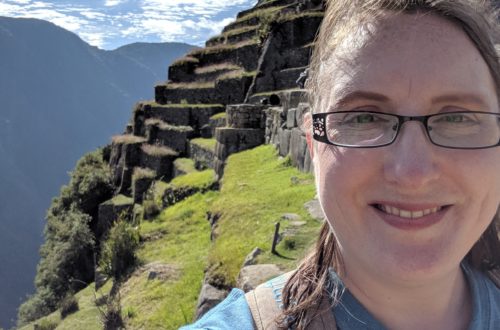
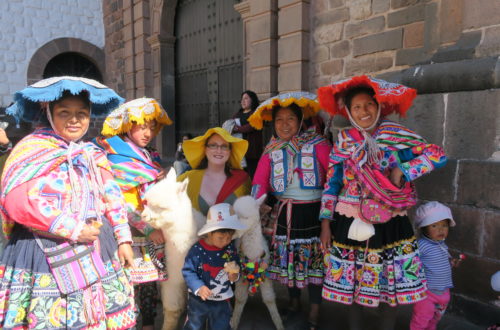

3 Comments
Diane Shaw
Sounds like an amazing trip. Thanks for sharing.
Tina
Thanks! The best is yet to come 🙂
Clare Tuma
Wow. What a day! I am exhausted reading about it! lol. I love the artsty photos of you!! I never thought of doing something like that. How clever and awesome. gosh I do remember all those parades. Amazing colors and costumes. I love how they are so devoted to their culture. I wonder if it will stand the test of time with future generations? Kudos on winning the Pisco sour quiz! Yay for Tina! Ok that L on your drink looks like Laverne and Shirley…sorry, I date myself! 🙂 Hot tub looked very relaxing and the pizza is definitely looking tastier than last night’s GP. It would be good if we could have some auditory commentary on all this. Looking forward to the next installment! Though this one has exhausted me. 🙂